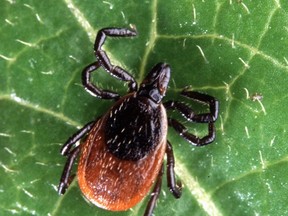
There was a lot of talk about ticks at Monday’s meeting of the Haldimand Norfolk Health and Social Services Advisory Committee meeting.
And while ticks are tough to get rid of, there are ways of protecting yourself from them, committee members were told.
“It is quite challenging to eradicate them,” Sarah Titmus, a program manager at the Haldimand Norfolk Health Unit, told the committee. “But there are things you can do for yourself, personally.
“For anyone outdoors in a wooded area, tick prevention should be top of mind.”
Titmus said wearing long-sleeved shirts, long pants that are tucked into socks as well as close-toed shoes is a good start. So is putting bug spray that says “DEET” on clothing rather than exposed skin.
Following a hike or walk, people should check for ticks on themselves, family members as well as pets within 24 hours, Titmus said.
Places to check include behind the knees, on the head, in the belly button, groin area and the underarms. Taking a shower can help wash away ticks.
Titmus presented a detailed report about the health unit’s role in preventing the spread of infectious disease in the community. She identified lyme-disease as one of the top five diseases of public health significance in Haldimand and Norfolk.
Titmus told the advisory committee that the case rate for lyme disease locally was 21.8 per 100,000 population. That’s well above the provincial average of 9.2 cases per 100,000.
Norfolk County Councilor Alan Duthie, a member of the advisory committee, called those statistics ‘fairly significant” and “quite concerning.”
Duthie asked if there is more that can be done to address the problem.
A recently completed community needs assessment found that the proportion of participants who reported completing a tick check after outdoor activities has decreased since 2019, Titmus said.
Lyme disease follows a bite from an infected black-legged tick and symptoms, which can include a bull’s eye rash, fever, chills, headache and fatigue, among others, usually appear three to 30 days after a bite.
Anyone who has symptoms should contact the health unit and their physician immediately.
Lyme disease can damage the heart, nerves, life and joints if its left untreated. Symptoms can last for years and can cause recurring arthritis and neurological problems, paralysis and in some rare cases, death.
Lyme disease like West Nile Virus and malaria, is a vector borne disease because it is transmitted to humans through a bite from an insect such as a tick, mosquito or flea.
Titmus said, in her report that public health officials will be collaborating on a health promotion campaign to decrease rates of all vector borne diseases in the two counties.
For more information about ticks and tick prevention visit www.ontario.ca/page/lyme-disease.
twitter.com/EXPVBall

Comments
Postmedia is committed to maintaining a lively but civil forum for discussion and encourages all readers to share their views on our articles. Comments may take up to an hour for moderation before appearing on the site. We ask you to keep your comments relevant and respectful. We have enabled email notifications—you will now receive an email if you receive a reply to your comment, there is an update to a comment thread you follow or if a user you follow comments. Visit our Community Guidelines for more information and details on how to adjust your email settings.
Join the Conversation